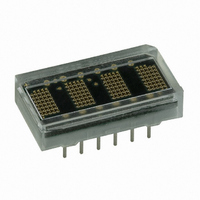HCMS-2963 Avago Technologies US Inc., HCMS-2963 Datasheet - Page 11

HCMS-2963
Manufacturer Part Number
HCMS-2963
Description
LED DISPLAY 5X7 4CHAR 5MM GREEN
Manufacturer
Avago Technologies US Inc.
Series
HCMS-29xxr
Datasheet
1.HCMS-2903.pdf
(16 pages)
Specifications of HCMS-2963
Display Type
Alphanumeric
Common Pin
*
Millicandela Rating
*
Internal Connection
*
Size / Dimension
0.85" L x 0.45" W x 0.21" H (21.5mm x 11.4mm x 5.3mm)
Color
Green
Configuration
*
Voltage - Forward (vf) Typ
*
Package / Case
12-DIP
Number Of Digits/alpha
4
Digit/alpha Size
0.20" (5mm)
Number Of Digits
4
Character Size
2.54 mm x 4.57 mm
Illumination Color
Green
Wavelength
574 nm
Operating Voltage
5 V
Operating Current
10 mA
Maximum Operating Temperature
+ 85 C
Minimum Operating Temperature
- 40 C
Luminous Intensity
114 ucd
Power Consumption
1.2 W
Viewing Area (w X H)
18.62 mm x 4.57 mm
Lead Free Status / RoHS Status
Lead free / RoHS Compliant
Lead Free Status / RoHS Status
Lead free / RoHS Compliant, Lead free / RoHS Compliant
Other names
516-1182-5
Control Word 1
Loading the Control Register with D
Control Word 1. This Control Word performs two func-
tions: serial/simultaneous data out mode and external
oscillator prescale select (see Table 2).
Serial/Simultaneous Data Output D
Bit D
D
Control Register writes. The default mode (logic low) is
the serial D
to the last bit (D
Storing a logic high to bit D
neous mode which affects the Control Register only. In
simultaneous mode, D
This arrangement allows multiple ICs to have their Control
Registers written to simultaneously. For example, for N
ICs in the serial mode, N * 8 clock pulses are needed to
load the same data in all Control Registers. In the simul-
taneous mode, N ICs only need 8 clock pulses to load
the same data in all Control Registers. The propagation
delay from the first IC to the last is N * t
External Oscillator Prescaler Bit D
Bit D
of an external Display Oscillator. When this bit is logic
low, the external Display Oscillator directly sets the inter-
nal display clock rate. When this bit is a logic high, the
external oscillator is divided by 8. This scaled frequency
then sets the internal display clock rate. It takes 512
cycles of the display clock (or 8 x 512 = 4096 cycles of
an external clock with the divide by 8 prescaler) to com-
pletely refresh the display once. Using the prescaler bit
allows the designer to use a higher external oscillator
frequency without extra circuitry.
This bit has no affect on the internal Display Oscillator
Frequency.
11
OUT
0
between serial and simultaneous data entry during
1
of control word 1 is used to switch the mode of
of Control Word 1 is used to scale the frequency
OUT
mode. In serial mode, D
7
) of the Control Shift Register.
OUT
is logically connected to D
0
changes D
1
0
7
= logic high selects
OUT
DOUTP
OUT
is connected
to simulta-
.
IN
.
Bits D
These bits must always be programmed to logic low.
Cascaded ICs
Figure 3 shows how two ICs are connected within an
HCMS-29XX display. The first IC controls the four left-most
characters and the second IC controls the four right-most
characters. The Dot Registers are connected in series to
form a 320-bit dot shift register. The location of pixel 0
has not changed. However, Dot Shift Register bit 0 of IC2
becomes bit 160 of the 320-bit dot shift register.
The Control Registers of the two ICs are independent
of each other. This means that to adjust the display
brightness the same control word must be entered
into both ICs, unless the Control Registers are set to
simultaneous mode.
Longer character string systems can be built by cascad-
ing multiple displays together. This is accomplished by
creating a five line bus. This bus consists of CE, RS, BL,
Reset, and CLK. The display pins are connected to the
corresponding bus line. Thus, all CE pins are connected to
the CE bus line. Similarly, bus lines for RS, BL, Reset, and
CLK are created. Then D
display. D
display. The left-most display receives its D
D
display is not used.
Each display may be set to use its internal oscillator, or
the displays may be synchronized by setting up one
display as the master and the others as slaves. The slaves
are set to receive their oscillator input from the master’s
oscillator output.
OUT
of the display to its right. D
2
-D
6
OUT
from this display is connected to the next
IN
is connected to the right-most
OUT
from the left-most
IN
from the










